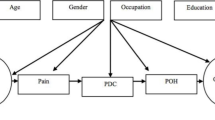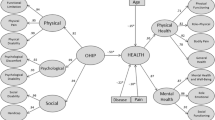Abstract
Purpose
The impact of oral health status on Taiwanese adults’ quality of life has not been measured definitively. This study evaluated the effects of oral health-related variables on quality of life among adults in Taiwan.
Methods
A cross-sectional study design with secondary database analysis was adopted. Information about oral health-related variables in adults aged 18–64 years was collected from the National Health Interview Survey and quality-of-life data from the Short-Form Health Survey (SF-36®). Univariate and multivariate regression analysis was used to determine risk factors for oral health and associations between oral health and eight domains of quality of life defined by the SF-36.
Results
Gender (P < 0.001), marital status (P < 0.001), monthly income (P < 0.001), disease history (P < 0.001), betel nut chewing (P < 0.001), oral hygiene (P < 0.001), oral health status (P < 0.001), and dental care utilization (P = 0.001) had significant effects on general health as an aspect of quality of life; gender (P < 0.001), marital status (divorced, P < 0.001), income level (20,000–80,000 NTD, P < 0.001), disease history (P < 0.001), oral hygiene, oral health-related food choice limitations (P < 0.001), and dental care utilization (P < 0.001) had significant effects on general mental health. Subjects who practiced dental self-care with tooth brushing had significantly higher social functioning scores than those who did not (P < 0.001). Significant differences were also found in scale items for physical functioning, role limitations due to physical health, bodily pain, vitality, and role limitations due to emotional problems (all P < 0.001).
Conclusions
Demographic (i.e., age, gender, and marital status and income levels) and oral health-related factors (i.e., oral hygiene, dental visits, disease history, and lifestyle factors such as cigarette smoking, alcohol use, and betel nut chewing) are all significantly associated with oral health-related quality of life in Taiwanese adults.
Similar content being viewed by others
References
Kuo, H. C., Yang, Y. H., Lai, S. K., Yap, S. F., & Ho, P. S. (2009). The association between health-related quality of life and prosthetic status and prosthetic needs in Taiwanese adults. Journal of Oral Rehabilitation, 36, 217–225.
Lee, I. C., Shieh, T. Y., Yang, Y. H., Tsai, C. C., & Wang, K. H. (2007). Individuals’ perception of oral health and its impact on the health-related quality of life. Journal of Oral Rehabilitation, 34, 79–87.
Ostberg, A. L., & Hall-Lord, M. L. (2011). Oral health-related quality of life in older Swedish people with pain problems. Scandinavian Journal of Caring Science, 20(3), 510–516.
Zhao, L., Lin, H. C., Lo, E. C., & Wong, M. C. (2011). Clinical and socio-demographic factors influencing the oral health-related quality of life of Chinese elders. Community Dental Health, 28(3), 206–210.
Chen, X., & Clark, J. J. (2011). Multidimensional risk assessment for tooth loss in a geriatric population with diverse medical and dental backgrounds. Journal of the American Geriatrics Society, 59(6), 1116–1122.
Chen, X., & Clark, J. J. (2011). Tooth loss patterns in older adults with special needs: A Minnesota cohort. International Journal of Oral Science, 3(1), 27–33.
Kumar, S., Goyal, A., Tadakamadla, J., Tibdewal, H., Duraiswamy, P., & Kulkami, S. (2011). Oral health-related quality of life among children with parents and those with no parents. Community Dental Health, 28(3), 227–231.
Rodd, H. D., Marshman, Z., Porritt, J., Bradbury, J., & Baker, S. R. (2011). Oral health-related quality of life of children in relation to dental appearance and educational transition. British Dental Journal, 211(2), E4.
Sanhouri, N. M., Ziada, H. M., Ahmed, G. I., & Kamis, A. H. (2010). Tooth surface loss, prevalence and associated risk factors among 12–14 years school children in Khartoum State, Sudan. Community Dental Health, 27(4), 206–212.
Atieh, M. A. (2008). Tooth loss among Saudi adolescents: Social and behavioural risk factors. International Dental Journal, 58(2), 103–108.
Segura-Saint-Gerons, R., Segura-Saint-Gerons, C., Alcantara-Luque, R., Arizon-DelPrado, J. M., Foronda-Garcia-Hidalgo, C., & Blanco-Hungria, A. (2011). Perceived influence of oral health upon quality of life in heart transplant patients. Medicina Oral, Patología Oral y Cirugía Bucal [ePub ahead of print].
Enger, T. B., Palm, O., Garen, T., Sandvik, L., & Jensen, J. L. (2011). Oral distress in primary Sjögrens syndrome: Implications for health-related quality of life. European Journal of Oral Sciences, 119(6), 474–480.
Luo, Y., & McGrath, C. (2008). Oral health and its impact on life quality of homeless people in Hong Kong. Community Dental Health, 25(3), 137–142.
Okoro, C. A., Strine, T. W., Eke, P. I., Dhingra, S. S., & Balluz, L. S. (2011). The association between depression and anxiety and use of oral health services and tooth loss. Community Dentistry and Oral Epidemiology,. doi:10.1111/j.1600-0528.2011.00637.x.
Taiwan National Health Interview and Medication Survey 2005. (2006). Survey research brief. Taipei, Taiwan: NHIS Working Group. http://nhis.nhri.org.tw (in Chinese).
Ware, J. E., & Sherbourne, C. D. (1992). The MOS 36-item Short Form Health Survey (SF-36): I. Conceptual framework and item selection. Medical Care, 30, 473–483.
Ware, J. E. (2000). SF-36 health survey update. Lincoln, RI: QualityMetric.
Ware, J. E., & Kosinski, M. (2001). How to score version 2 of the SF-36 ® health survey (standard and acute forms) (2nd ed.). Lincoln, RI: QualityMetric.
Ware, J. E., Snow, K. K., Kosinski, M., & Gandek, B. (1993). SF-36 Health Survey manual and interpretation guide. Boston, MA: The Health Institute, New England Medical Center.
Ware, S. D., Keller, B., Gandek, B., Brazier, J. E., & Sullivan, M. (1995). Evaluating translations of health status questionnaire: Methods from the IQOLA project. International Journal of Technology Assessment in Health Care, 11, 525–551.
Brennan, D. S., Spencer, A. J., & Roberts-Thomson, K. S. (2008). Tooth loss, chewing ability and quality of life. Quality of Life Research, 17(2), 227–235.
Shimada, A., Sasaki, Y., & Mataki, S. (2005). An evaluation of self-reported oral health and health-related quality of life. Journal of Medical and Dental Science, 52(1), 65–72.
Jones, J. A., Kressin, N. R., Kazis, L. E., et al. (2006). Oral conditions and quality of life. Journal of Ambulatory Care Manage, 29(2), 167–181.
Haugejordan, O., Klock, S., & Trovik, T. A. (2003). Incidence and predictors of self-reported tooth loss in a representative sample of Norwegian adults. Community Dentistry and Oral Epidemiology, 31(4), 261–268.
Sk, Ng., & Leung, W. K. (2006). Oral health-related quality of life and periodontal status. Community Dentistry and Oral Epidemiology, 34, 114–122.
Moreira, R. D., Nico, L. S., Barrozo, L. V., & Pereira, J. C. R. (2010). Tooth loss in Brazilian middle-aged adults: Multilevel effects. Acta Odontologica Scandinavica, 68(5), 269–277.
Klein, B. E. K., Klein, R., & Knudtson, M. D. (2004). Lifestyle correlates of tooth loss in an adult midwestern population. Journal of Public Health Dentistry, 64, 145–150.
Liu, L. J., Xiao, W., He, Q. B., & Jiang, W. W. (2010). Generic and oral quality of life is affected by oral mucosal diseases. BMC Oral Health, 12, 2.
Armellini, D. B., Heydecke, G., Witter, D. J., & Cruegers, N. H. (2008). Effect of removable partial dentures on oral health-related quality of life in subjects with shortened dental arches: A 2-center cross-sectional study. International Journal of Prosthodontics, 21, 524–530.
Johansson, V., Axelius, B., Söderfield, B., Sampogna, F., Paulander, J., & Sondell, K. (2010). Multivariate analyses of patient financial systems and oral health-related quality of life. Community Dentistry and Oral Epidemiology, 38, 436–444.
World Health Organization. (1982). A review of current recommendations for the organization and administration of community oral health services in Northern and Western Europe. Report of a WHO workshop, Oslo.
Conflict of interest
The authors declare that they have no conflict of interest, and no funding support was received for this study.
Author information
Authors and Affiliations
Corresponding author
Appendix
Rights and permissions
About this article
Cite this article
Wang, TF., Chou, C. & Shu, Y. Assessing the effects of oral health-related variables on quality of life in Taiwanese adults. Qual Life Res 22, 811–825 (2013). https://doi.org/10.1007/s11136-012-0205-8
Accepted:
Published:
Issue Date:
DOI: https://doi.org/10.1007/s11136-012-0205-8




